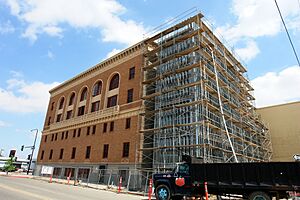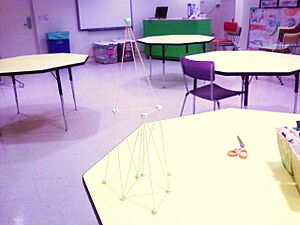Fresno Metropolitan Museum of Art and Science facts for kids
 |
|
| Established | April 8, 1984 |
|---|---|
| Dissolved | January 5, 2010 |
| Location | Fresno, California |
The Fresno Metropolitan Museum of Art and Science, often called "The Met," was a special museum in Fresno, California. It was a place where people could explore both art and science. The museum opened in 1984 and became one of the biggest museums between San Francisco and Los Angeles. It was located in the old Fresno Bee Building, which was built in 1922.
The museum was connected to the Smithsonian Institution and was recognized by the American Alliance of Museums. This meant it met high standards for museums. In 2005, the museum started a big project to update its inside. It reopened in 2008 but sadly closed for good in 2010.
Contents
About the Fresno Met Museum
A Look Back: The Museum's Story
A group of leaders in Fresno started planning a museum for the San Joaquin Valley in 1978. They worked hard and raised over $5.5 million. This money helped them open The Met in the historic Fresno Bee building. The museum first welcomed visitors on April 8, 1984.
Over the years, more than two million people visited The Met. They enjoyed many different art and science shows. Some famous exhibits included A T. rex Named Sue and Georgia O'Keeffe: Visions of the Sublime. There was also Grossology: The (Impolite) Science of the Human Body, which was very popular.
The museum also won important awards. In 1995, it received an "Award for Excellence" for how well it was managed. It was also named the "Best Museum" by readers of The Fresno Bee newspaper every year from 1999.
Sadly, the museum closed its doors forever on January 5, 2010. It could not pay for the costs of its big renovation and daily operations.
Big Changes: The Renovation Project
The museum had a huge $28 million renovation project. This project updated the old 1922 Fresno Bee Building for modern times. It made the art galleries easier to get to. New restrooms and elevators were added. The fourth and fifth floors were also remodeled. These floors had never been open to the public before.
The building's structure was made much stronger. Especially the west wall, from the very bottom to the top floor. Support columns in the basement and first floor were also improved. The museum reopened on November 13, 2008, after all this work.
The fourth floor became a large gallery space. It was also used for educational events. The Michaelis Classroom was right next to it. The fifth floor held the museum's offices. It also had a meeting room and a research library.
Learning on the Go: Outreach Programs
While the museum was being renovated, it still offered programs. The Reeves Family ASK Science Center moved to a temporary spot. It was a hands-on science area with changing exhibits. It stayed open from 2005 until 2008. After the renovation, it moved back inside the museum.
The museum also had many programs to reach out to the community:
- The Mobile Met Science Outreach program visited schools and other groups. It offered free, hands-on science lessons. These lessons were for kids in kindergarten through sixth grade. They followed California's science standards.
- The Docent Outreach Project helped teachers bring museum lessons to their classrooms. This program offered one-hour art lessons for grades 1 to 3.
- Visual Thinking Strategies (VTS) used art to teach important skills. Kids learned critical thinking, communication, and how to understand images. These lessons were free and offered in English, Spanish, and Hmong.
- The Met on the Move program started in October 2008. It used a special vehicle to bring art and science activities to elementary schools. It was part of Fresno's mobile fleet for after-school programs.
What Happened Next?
After the museum closed, the city of Fresno took over the building. It was empty for two years. Then, in April 2012, a new public access station moved in. This station is called Community Media Access Collaborative (CMAC). CMAC uses the second floor of the building. They continue to show art from local artists. The other floors of the building are still empty.




